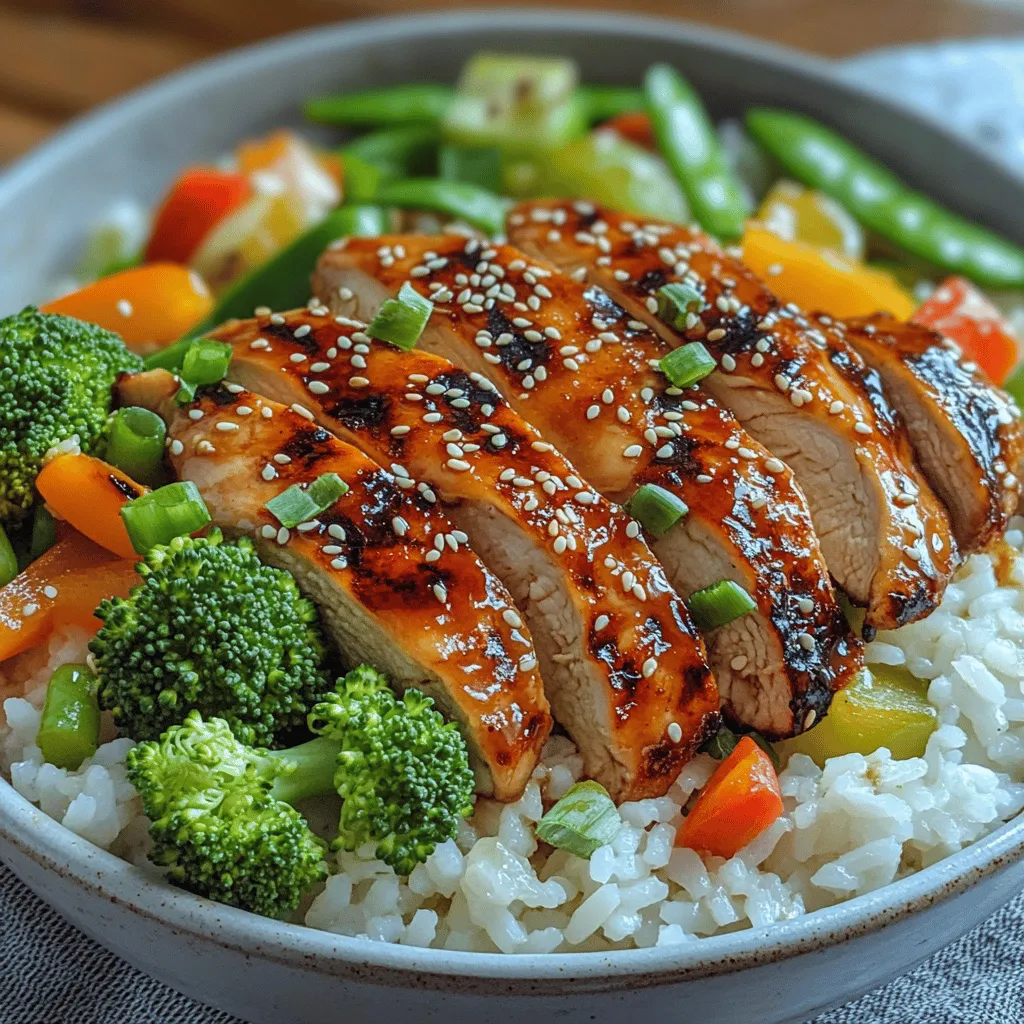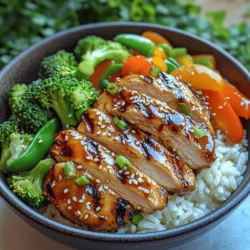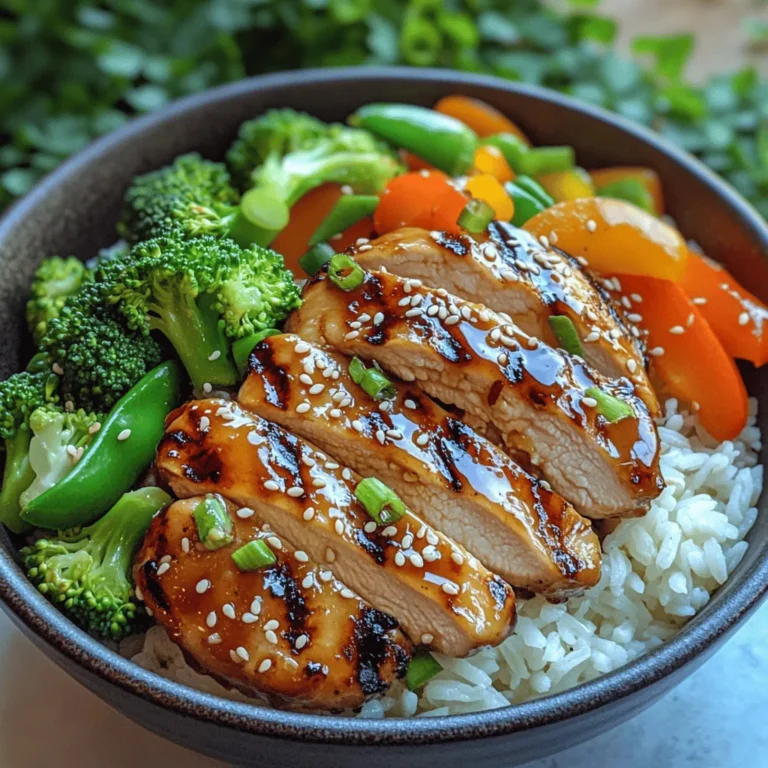Teriyaki Chicken Bowls are a delightful and nutritious meal option that combines the irresistible flavors of Japanese cuisine with the wholesome goodness of proteins, vegetables, and grains. This dish has gained immense popularity worldwide, thanks to its savory-sweet teriyaki sauce that tantalizes the taste buds. By incorporating a balanced mix of chicken, vibrant vegetables, and rice, the Teriyaki Chicken Bowl is not only delicious but also a satisfying meal that caters to various dietary needs.
Understanding the allure of teriyaki sauce is essential for appreciating this dish. Traditionally, teriyaki sauce is a blend of soy sauce, mirin, and sugar, creating a rich glaze that enhances the flavor of the main ingredient, usually chicken. Choosing the right cut of chicken, such as thighs for juiciness or breasts for leaner options, can also make a significant difference in the overall taste and texture.
Ingredients
– 1 lb boneless, skinless chicken thighs (or breasts)
– 1/3 cup soy sauce (low sodium recommended)
– 1/4 cup mirin
– 2 tablespoons honey (or maple syrup)
– 1 tablespoon fresh ginger, minced
– 2 cloves garlic, minced
– 1 tablespoon sesame oil
– 1 tablespoon cornstarch (optional)
– 2 cups broccoli florets
– 1 bell pepper, sliced (any color)
– 1 cup snap peas
– 1 cup carrots, sliced
– 2 tablespoons olive oil
– Cooked jasmine or brown rice (for serving)
– Sesame seeds (for garnish)
– Green onions, chopped (for garnish)
Instructions
1. In a mixing bowl, combine soy sauce, mirin, honey (or maple syrup), minced ginger, garlic, and sesame oil to create the teriyaki marinade.
2. Add the chicken to the marinade, ensuring it is thoroughly coated. Cover and let it marinate in the refrigerator for at least 30 minutes or up to 2 hours for deeper flavor.
3. In a large skillet or wok, heat olive oil over medium-high heat. Add the marinated chicken, reserving the marinade for later use.
4. Cook the chicken for about 5-7 minutes on each side until fully cooked and golden brown. Remove the chicken from the skillet and set aside.
5. In the same skillet, add the broccoli, bell pepper, snap peas, and carrots. Stir-fry for about 3-5 minutes until the vegetables are tender-crisp.
6. Return the chicken to the skillet and pour the reserved marinade over the chicken and vegetables. If using cornstarch, mix it with a little water to create a slurry and add it to the pan to thicken the sauce.
7. Cook for an additional 2-3 minutes, stirring to ensure everything is well coated and heated through.
8. Serve the teriyaki chicken and vegetables over a bed of jasmine or brown rice, garnished with sesame seeds and chopped green onions.
Understanding Teriyaki Chicken
Teriyaki, a cooking technique that involves grilling or broiling food with a glaze of soy sauce and sugar, holds a significant place in Japanese culinary traditions. The term “teriyaki” itself comes from the method of cooking, where “teri” refers to the shine of the sauce, and “yaki” means grilling. This method not only adds flavor but also creates a beautiful caramelized exterior.
The key ingredients of teriyaki sauce include soy sauce, mirin, sugar, and sometimes sake, each contributing to the sauce’s unique umami flavor. When preparing Teriyaki Chicken, choosing chicken thighs is often preferred due to their higher fat content, which results in a juicier and more flavorful dish. In contrast, chicken breasts are a leaner option that appeals to those seeking a healthier choice.
Ingredients Breakdown
When preparing Teriyaki Chicken Bowls, understanding the role of each ingredient can elevate the dish.
– Boneless, Skinless Chicken: This is the primary protein source, rich in essential nutrients such as protein, vitamins, and minerals.
– Soy Sauce: Opting for low-sodium soy sauce helps control salt intake while still providing the necessary umami flavor.
– Mirin: This sweet rice wine is essential for balancing the flavors in the marinade, adding depth and complexity.
– Honey vs. Maple Syrup: Both sweeteners provide a unique flavor profile; honey brings a floral sweetness, while maple syrup offers a distinct earthy note.
– Fresh Ginger and Garlic: These ingredients not only enhance the flavor but also offer health benefits, including anti-inflammatory properties.
– Sesame Oil: A little goes a long way in adding a nutty flavor that complements the other ingredients.
– Optional Cornstarch: Used for thickening the sauce, it can create a glossy finish that clings beautifully to the chicken and vegetables.
The vegetables in this dish also play a crucial role, providing not just nutrition but a burst of color and texture. Broccoli, bell peppers, snap peas, and carrots are all excellent sources of vitamins and minerals, making this meal a wholesome choice. The addition of olive oil and proper seasoning further enhances the natural flavors of the vegetables.
Step-by-Step Cooking Instructions
The preparation of the teriyaki marinade is a crucial step in creating a flavorful Teriyaki Chicken Bowl. Start by combining the soy sauce, mirin, honey, minced ginger, garlic, and sesame oil in a bowl. This blend of ingredients will create a rich, sweet, and savory marinade that will infuse the chicken with flavor.

Tips for Perfecting Your Teriyaki Chicken Bowl
Importance of Marinating for Flavor Infusion and Tenderness
Marinating the chicken is crucial for enhancing the flavor and ensuring tenderness. The marinade not only infuses the meat with the distinct sweet and savory notes of teriyaki but also helps to break down tougher fibers, resulting in a juicy bite.
Marination Process
To marinate effectively, combine soy sauce, mirin, sake, and a sweetener like brown sugar or honey. Allow the chicken to soak in this mixture, turning occasionally to ensure even coverage.
Recommended Time Frames for Optimal Flavor Absorption
For the best results, marinate your chicken for at least 30 minutes, but ideally for 2 to 4 hours. If you have more time, overnight marination will yield the most flavorful and tender results.
Cooking the Chicken
The method you choose to cook the chicken can significantly impact the final dish.
Techniques for Achieving Perfectly Grilled or Pan-Seared Chicken
For grilling, preheat your grill to medium-high heat and cook the chicken for about 6-8 minutes per side, depending on thickness, until a nice char forms. For pan-searing, heat a tablespoon of oil in a skillet over medium-high heat, cooking the chicken until golden brown and cooked through.
Importance of Resting the Chicken Post-Cooking
Let the chicken rest for at least 5 minutes after cooking. This allows the juices to redistribute, ensuring each bite is moist and flavorful.
Creating the Teriyaki Sauce
Homemade teriyaki sauce can elevate your dish to new heights.
How to Avoid Common Mistakes When Thickening Sauces
To thicken your sauce, avoid high heat, which can cause the sugars to burn. Instead, simmer on low heat while constantly stirring until it reaches your desired consistency.
Importance of Balancing Flavors in the Sauce
Aim for a balance of sweet, salty, and umami. Adjust the sweetness with honey or sugar and add a splash of rice vinegar for acidity to enhance overall flavor.
Steaming the Vegetables
Steaming is an excellent method for preserving the nutrients and vibrant colors of your vegetables.
Techniques for Achieving the Perfect Texture (Tender Yet Crisp)
Steam your vegetables until they are bright in color and just tender, usually about 3-5 minutes. This method keeps them crisp, preventing them from becoming mushy.
Importance of Seasoning Vegetables Post-Steaming
After steaming, lightly season with salt and a dash of sesame oil to enhance their natural flavors.
Assembling the Bowls
The way you assemble your teriyaki chicken bowl can elevate both its presentation and flavor.
Layering Techniques for Visual Appeal and Flavor Distribution
Start with a base of rice or quinoa, then layer the chicken, followed by steamed vegetables. This not only looks appealing but allows the flavors to blend beautifully.
Garnishing Tips
Don’t underestimate the power of garnishes. Adding sesame seeds, chopped green onions, or pickled ginger can enhance both presentation and taste, providing texture and a burst of flavor.
Nutritional Value of Teriyaki Chicken Bowls
Teriyaki chicken bowls are not just delicious; they also offer a well-rounded nutritional profile.
Breakdown of Calories, Protein, Carbs, and Fat Content Per Serving
A typical serving contains approximately 400-500 calories, with 30g of protein, 45g of carbohydrates, and around 15g of fat, depending on specific ingredients and portions used.
Health Benefits of the Ingredients
This dish is packed with lean protein from the chicken, vitamins and minerals from the vegetables, and fiber from whole grains like brown rice or quinoa, making it a nutritious option.
Discussion on the Dish’s Suitability for Various Dietary Preferences
Teriyaki chicken bowls can easily be adapted for various dietary needs. For gluten-free options, simply use tamari instead of soy sauce and explore protein alternatives like tofu or shrimp.
Variations on the Teriyaki Chicken Bowl
Suggestions for Alternative Proteins
Mix it up by substituting chicken with tofu for a vegetarian option, shrimp for a seafood twist, or beef for a heartier meal.
Seasonal Vegetable Substitutions
Incorporate seasonal vegetables such as asparagus in spring, zucchini in summer, or roasted root vegetables in fall to keep your dish fresh and exciting year-round.
Creative Twists
Get creative by adding diced pineapple for a tropical flair or experimenting with spicy teriyaki sauce variations to cater to different palates.
Conclusion
Teriyaki chicken bowls stand out as a versatile and healthy meal option that appeals to a wide range of tastes. By exploring the intricacies of Japanese cuisine through home cooking, you can enjoy the satisfaction of creating a delicious meal from scratch. Embrace the joy of cooking and sharing these delightful bowls with family and friends, celebrating the flavors and traditions they encompass.


